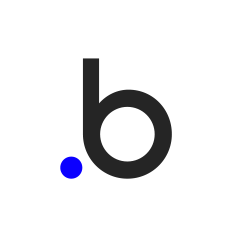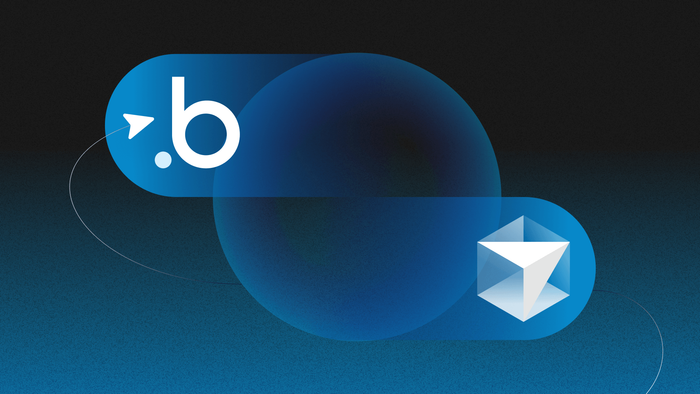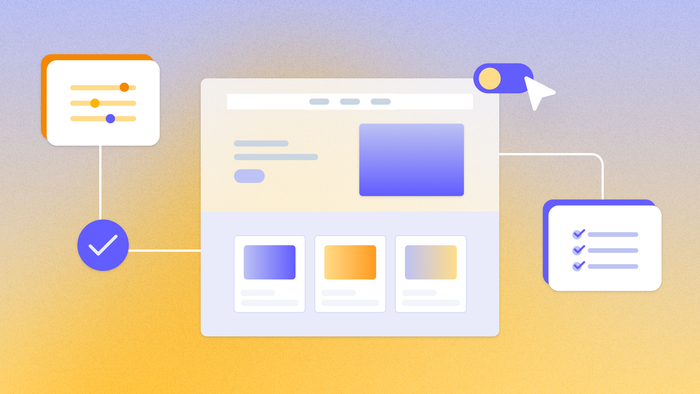If you’ve been exploring the vibe-coding, AI-coding, or no-coding scene for more than a few minutes, you’ve probably already heard a half-dozen suggestions for the “best” tool to use for your next project.
The truth is: The best tool depends on your needs, your goals, what you’re hoping to build, and how much technical experience you have. There’s no one “right” tool right now — just the right tool for you.
We’re here to break down two popular tools — Bubble and Cursor — side by side, so you can see which is better for your next project.
Bubble is an AI-powered, no-code software development platform that gives everyone the tools to build and launch fully functional apps through visual programming. Bubble uses AI-assisted visual development to speed up and democratize software development, allowing anyone to take an app from idea to finish line while remaining in control the whole time. AI tools on Bubble help builders escape the blank page and start building faster, while a drag-and-drop editor allows you to customize every aspect of your app.
Cursor is an AI-integrated, text-based coding environment that allows software engineers to code faster and speed up workflows through integrated AI assistance. It provides a familiar development space to write, edit, and debug code, with two integrated AI agents to help support and speed up coding tasks like writing code and fixing bugs. It relies on the developer’s knowledge to guide the process, with the AI as an assistant.
Although these two tools both focus on speeding up development, they take drastically different approaches, so it’s difficult to compare them directly. Instead, we’ll break down some of the key differences between the two tools to help you choose the one that makes the most sense for you.
Cursor vs. Bubble: Key differences
Yes, Bubble and Cursor are both tools that can help you build software faster — but the ways they support builders are completely different. There are four core questions that can help you decide which tool is right for you:
- Do you want to primarily work with code or use a visual, drag-and-drop interface to design and program your app instead?
- Are you looking for a tool to speed up one of your existing workflows or an all-in-one place to build and launch your app?
- How do you want to use AI as you work?
- What’s your level of technical expertise — are you an experienced developer or a beginner?
Here’s how Cursor and Bubble stack up on each of these:
Drag-and-drop vs. code
The biggest and most significant difference between these two tools is how they manage and use the code that powers your software.
Bubble is a no-code, AI-powered visual development platform. In plain English, Bubble’s editor is visual, not text-based. It “abstracts” the code — aka puts it under a visual layer — so you can drag-and-drop items to build out your design and your app’s functionality instead of working directly with code.
For example, instead of writing a few lines of code that would design a button, you can click and drag the “button” element from the sidebar and drop it to where you want it on the page. Pop-up menus allow you to adjust padding, width, colors, what happens when the button is clicked, and more, all without code.
Bubble uses this visual programming model for every layer of your app: design, data, and logic — that is, how your app looks and how it works. This way, the program speaks your language, rather than you having to learn a programming language.
Cursor is an AI-supported code editor that uses a traditional text-based editor for writing code. It’s a developer-first tool that focuses on code output. There isn’t any visual output, preview, or editor — so you’ll need to understand and feel comfortable with code to use Cursor effectively.
Cursor has two AI models: Ask, which allows you to ask questions about your code without making changes; and Agent, which can explore, plan, and write code for you, or help fix errors. And while the AI agent is pretty good (and fast) at code generation, you do need to be able to read and understand that code to test if it’ll work, find bugs, make changes and add advanced functionality, and so on.
Without any sort of visual support, Cursor is designed to speed up workflows for experienced developers and provide deeply integrated AI support into an environment similar to Visual Studio Code. Cursor works best with Python and JavaScript, but it can work with any programming language.

To code or not to code? That comes down to your confidence and coding experience. On Bubble, everything is visual; with Cursor, everything is code-based. Some reviewers claim that you can build complex, functional apps in Cursor without coding knowledge. That may be true to some extent, but you’ll be flying blind if you can’t understand the code the AI agent is generating for you.
In the long run, you’ll have a much steeper learning curve and less practical control, since you’ll have to rely on AI to manage and iterate on code you don’t understand yourself. If and when the AI gets stuck, or you encounter bugs you can’t troubleshoot and the AI can’t fix, you’ll be stuck.
Platform vs. tool
Software is more than just code. To build and launch a fully-functional app, you’ll need a database, a server for hosting and deployment, integrations with other apps, security, and more.
Bubble is an all-in-one platform for building, launching, and scaling app-based businesses. Cursor is a tool for writing code faster. Bubble helps builders manage the entire end-to-end software development process, from launch and beyond. Cursor leaves non-developers hanging, as it doesn’t help with other aspects of development beyond writing code.
Consider some of the other tools you’ll need to get to a fully-functional app:
- Database. Bubble has a built-in database, which means your app’s data (and your end-user data, like logins, profile info, etc.) are all stored within Bubble. You don’t need a separate platform to manage the data for your app or connect it to your app’s frontend or functionality. With Cursor, you’ll need to set up and manage a database externally (i.e., with Supabase, Firebase, or another similar platform). You’ll also need to understand what to set up, and how, or rely on AI to do so for you.
- Integrations. Integrations connect your app to other apps to extend functionality. For example, you might want your app to connect to Stripe to collect payments, or Google Maps to show search results on a map. Bubble has thousands of built-in plugins and integrations that are maintained by experts. On Cursor, you’ll need to code your own (and keep up with updates manually).
- Hosting and deployment. Once your software is ready to go, you’ll need somewhere to host your app for end users. On Bubble, the hosting (where your app lives) and deployment (how you move the code to the server hosting your app) process is one-click: Just click Deploy and you’re ready to go live. On Cursor, you’ll need to manage hosting on your own or work with a third-party hosting platform, and you’ll need to export the code and deploy it manually.
Neither of these options are intrinsically better or worse than the other; it just depends on what you are comfortable with, your level of background knowledge and technical expertise, and your needs and goals.
If you’re confident pulling together disparate services and tools to build a full-stack app, then Cursor can be a great part of your tech stack for writing, debugging, and iterating on code faster. If you’re not confident managing design, data, logic, deployment, and all the rest manually — or aren’t sure what you’ll need — an all-in-one platform like Bubble will help you get your app functional and live far faster and with less stress.
AI capabilities
Both Bubble and Cursor have integrated AI, but in very different ways.
Bubble leads with AI to solve the blank page problem, giving you an AI-generated V1 of your app in the first ten minutes. With Bubble’s AI app generator, you start with a prompt describing your app and key features, then Bubble’s AI works to create the first draft of your app. You get a functional app with frontend UI (design), backend databases with sample data, and workflows (the logic that powers how your app works).
All of that is created in Bubble’s visual editor, so you can see and test your app as it’ll look for end-users, and you can add and iterate on design or functionality right away. Bubble’s editor also has a built-in AI chatbot that can walk you through how to do most things in the Bubble editor. We’re also working on integrating AI throughout the entire development process. Soon, on Bubble, you’ll be able to:
- Iterate on your Bubble app with AI directly in the editor
- Use AI to help you find and fix errors in your Bubble app
- Develop mobile apps with the power of AI + no-code
If you want to use AI in your app — and not just to build it — Bubble’s expert-maintained plugins allow you to integrate OpenAI LLMs like ChatGPT, and other LLMs like Claude, DALL-E, Grok, Gemini, and more into your app.
Cursor uses AI as a co-pilot for writing, debugging, and iterating on your code. It can serve as a researcher and resource to ask questions about your code (in Ask mode) or it can help you write, debug, and fix your code directly (Agent mode). Cursor’s AI is good for:
- Writing and running terminal commands
- Detecting lint errors automatically and debugging
- Making multi-line edits to your code
- Autocorrect for your simple code typos
- Referencing and searching your code to help answer your questions, spot errors, and make improvements
So, how do you want to use AI for your project?
If you’re looking for an AI assistant for coding, Cursor offers a great option. If you’re looking for AI to spin up the entire V1 of your app and support you as you build, Bubble provides a simpler, faster, option.
Target audience
Who are you? And we don’t mean that as a philosophical dilemma — just that Bubble and Cursor cater to very different audiences.
Bubble allows anyone to build full-stack apps regardless of programming experience, while Cursor is intended for developers who understand code.
Can non-coders use Cursor? Of course. But the tool will primarily generate a lot of code, very quickly, that you won’t understand. So when you run into errors, bugs, or just need help — you’re going to be, well, more than a bit stuck.
Bubble gives you a platform that works the way you do — visually, where you can literally see how each change works and impacts your app as you make it. Bubble lets you stay in control the entire time, rather than forcing you to work with code you don’t fully understand.
It’s not just about code, either. On Cursor, you need to understand all the complexities of how software works, software architecture, programming languages, and so on to effectively prompt the AI and build your app. Bubble’s visual editor is much more intuitive for nontechnical users, and doesn’t require a programming background to get started.
Can coders use Bubble? Yes, for sure! Building on Bubble makes you faster by eliminating many of the tedious coding tasks using drag-and-drop building, without losing the functionality available through coding. Plus, many developers find Bubble super easy to learn, since Bubble’s visual programming follows the same programming rules and logic as coding does.
Besides how accessible and fast no-code development is, Bubble has a huge library of educational resources for all skill levels, from true beginners to experienced developers. If you want to learn the basics of Bubble to build your first app, you can find how-tos, getting started guides, and beginner courses to help you build step-by-step. If you’re an experienced developer, advanced and detailed docs in the manual or YouTube channel will show you how to get the most out of the Bubble platform.
Bubble vs. Cursor: Which is right for you?
AI coding and no-code aren’t replacements for one another — they solve different aspects of the challenges of software development. AI coding tools can be a great way to speed up the process of spinning up V1 of your app, and can give experienced programmers super-speed as they work on code.
With no-code, anyone can build an app from start to finish, and remain in control the whole time. Non-coders won’t run into AI prompt loops, where you’re trying to fix bugs through AI and not getting the results you want.
And for experienced developers, no-code can still be a game-changer. An all-in-one no-code platform like Bubble not only makes the development process way faster, it also makes the long-term development and maintenance of your app much easier. You don’t have to manage servers, balance loads, do endless debugging, or manage other technical details during iterations. You get the power of code, without the tedious work of coding every element line-by-line.
| Bubble Pros | Bubble Cons |
|---|---|
|
✅ No-code visual programming for every aspect of your app (design, data, and logic) makes building apps accessible for anyone. |
❌ Developers may prefer traditional coding environments that feel familiar and use code directly. |
|
✅ AI can spin up the first version of your app in minutes, complete with functionality and sample data. |
❌ AI doesn’t (yet) iterate or build functionality for you beyond the initial generation. |
|
✅ Stay in control the whole time, even if you don’t know code. |
|
|
✅ Get built-in security features and automated vulnerability checks, so you can take your app live faster and feel confident your data is secure. |
|
|
✅ All-in-one platform gives you everything you need to build, launch, and scale a fully-functional app. |
|
| Cursor Pros | Cursor Cons |
|
✅ Not locked into a single platform... |
❌ ...but you have to piece together your entire tech stack (frontend, database, hosting server, etc.) on your own. |
|
✅ Access to the underlying code. |
❌ You need to be confident and comfortable working with code to build a scalable app. |
|
✅ More familiar coding environment for experienced developers. |
❌ Steep learning curve for non-coders. |
|
✅ Flexibility for any programming language. |
As you can see, on many elements, whether a certain feature is a “pro” or a “con” depends on your needs and level of experience.
In our opinion: Cursor is better for experienced developers who want to seamlessly integrate AI into their development environment to speed up workflows and ship faster. When you’re working with existing tech stacks, familiar programming languages, and strong expertise, Cursor gives you a flexible and familiar environment with an AI co-pilot to help you work faster and speed up the tedious parts of coding and debugging.
Bubble is best for non-coders who want to build and scale businesses, not just apps. Bubble is the only AI-powered visual development platform that combines the speed of AI with scalability and control. It gives anyone the ability to create production-grade apps and enterprise software, without having to code. Even non-technical builders get full control and customization through the visual editor, combined with the speed of AI generation to eliminate the blank page dilemma and introduce you to the platform.
Plus, you get built-in hosting, an all-in-one platform with a strong database and integrations, a huge community with tons of resources, and a platform you can understand without a technical background, which makes managing and scaling all aspects of your app accessible for anyone.
Curious how other no-code AI builders stack up? Check out our other comparisons:
Build your app on Bubble's Free plan. No need to upgrade until you're ready to launch your app.
Join Bubble





